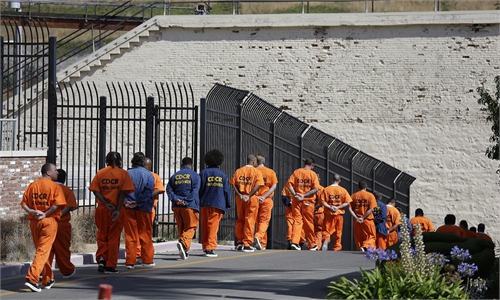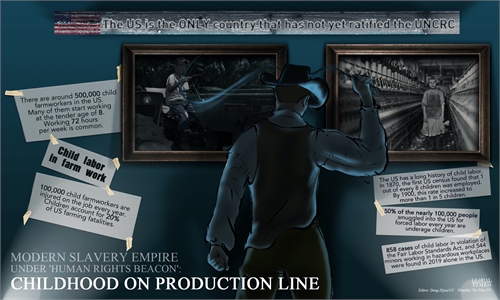GT investigates: How US exploits minority workers and immigrants in agriculture and other labor-intensive industries
Blood, sweat and tears
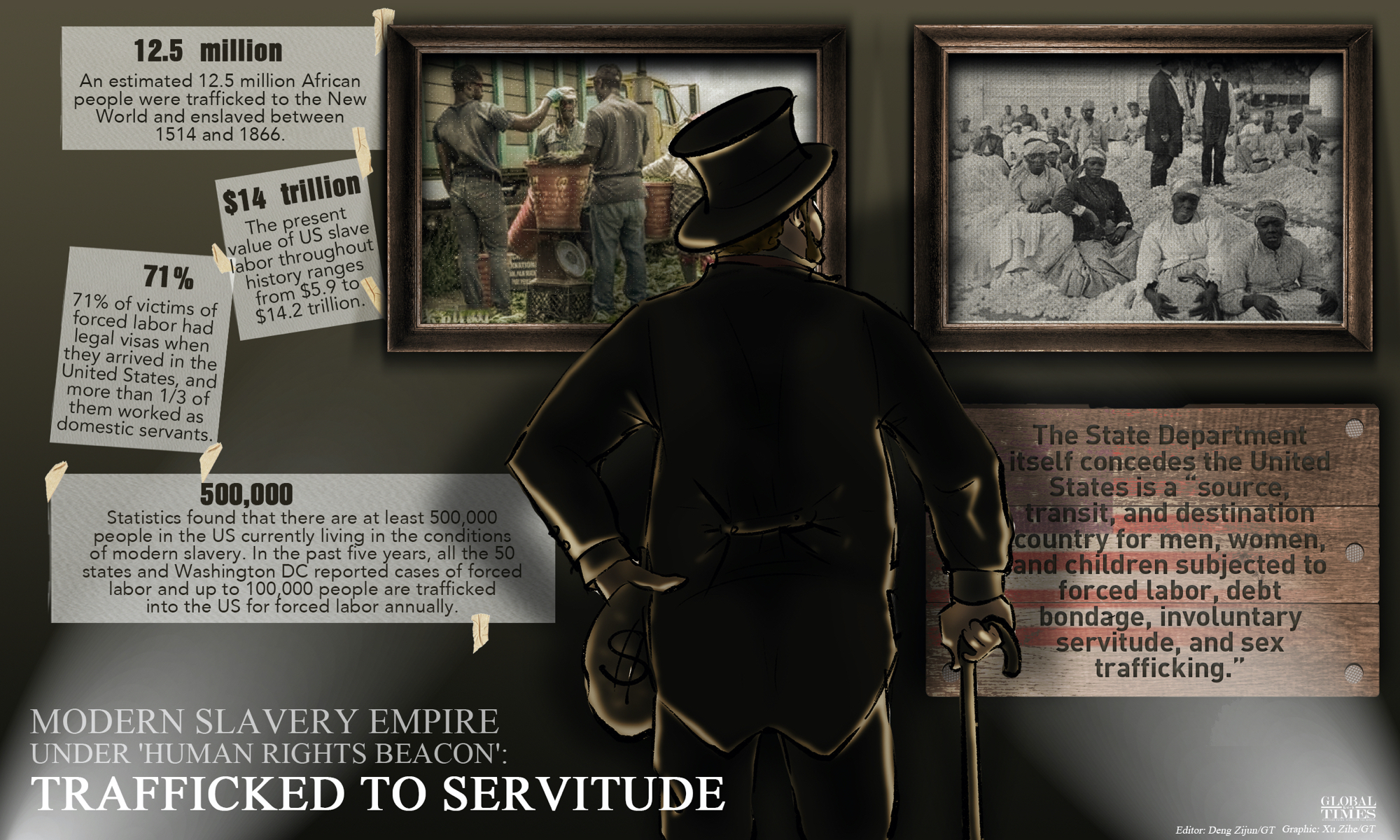
Graphic: Xu Zihe/GT
Editor's Note:
Inmates in prisons are subject to labor exploitation, minors working as child laborers are abused, and human trafficking remains rampant: Today, more than 150 years after the abolition of slavery in the US, the above-mentioned problems still exist in the country. Some American politicians have racked their brains to fabricate the "sad narrative" of "forced labor" in China's Xinjiang region, but a lie repeated a thousand times is still a lie. It is the US, a self-proclaimed "human rights defender" or a "beacon of freedom," that stands accused of using forced labor, which plainly demonstrates the US' real disregard for basic human rights and its brutal exploitation of the country's workforce.
The Global Times is publishing a series of articles that will uncover the four "crimes" of the US, a real "contemporary slavery empire." The following is the third installment of this series - The longest exploitation: How the US, the empire of "modern slavery," exploits minority groups and immigrant workers.
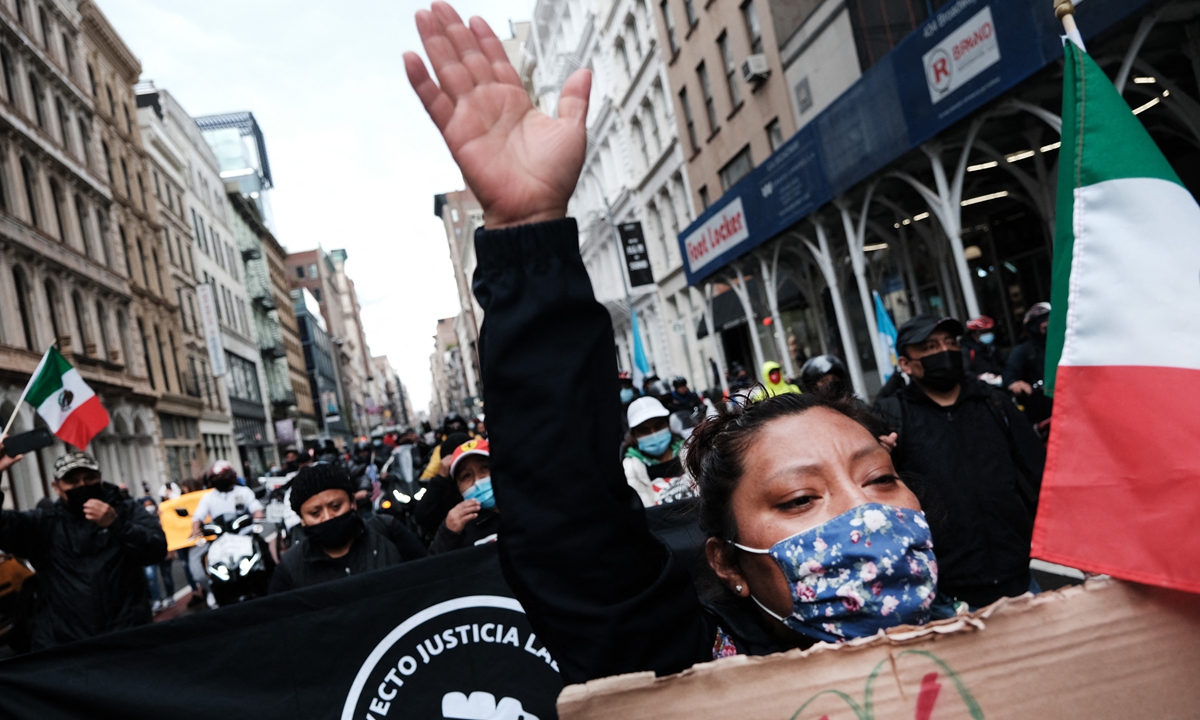
Hundreds of delivery workers, many of them immigrants, participate in a protest and march down Broadway to City Hall on April 21, 2021 in New York City. Photo: AFP
While the US likes to claim itself as a defender of "human rights," forced labor - an ugly legacy of slavery - is still deeply rooted in the contemporary US society. The only difference is that the victims have changed their status from black slaves to minority groups and immigrant workers, but they are still suffering the same brutal, inhumane treatment, including long working hours, little or no pay, and various abuses including confinement and sexual harassment among many others.It's been estimated that currently at least 500,000 people are living under modern slavery and forced labor conditions in the US, according to the University of Denver website. Forced labor is prevalent in 23 industries, including domestic service, agriculture, catering, medical care, and beauty. Human trafficking is also found in these sectors. Up to 100,000 people are trafficked into the US for forced labor annually.
In June, 53 people were found dead inside a sweltering tractor-trailer in southern Texas, one of the deadliest human trafficking tragedies along the US-Mexico border in recent history.
For those being trafficked, many are bound for forced labor. In the Typology of Modern Slavery, Polaris - an NGO founded in 2002 dedicated to helping victims held in slavery in the US - analyzed more than 32,000 cases of human trafficking between December 2007 and December 2016. This is the largest data set on human trafficking in the US ever compiled and publicly analyzed, according to Polaris. The research found such people are exploited in different ways from sex trafficking within escort services to the trafficking of farm laborers. In total, it identified 25 types of brutal human trafficking in the US in its Typology of Modern Slavery report.
Between December 7, 2007, and December 31, 2016, the hotlines that Polaris operated received 10,085 calls of potential cases of labor exploitation. Among those cases, Polaris found that workers "endure a wide range of abuses that put them at high risk for labor trafficking. These abuses include wage and hour violations, contract violations, sexual harassment, discrimination, child labor violations, and unsafe working conditions."
"Polaris strongly believes that labor trafficking cases in the US are chronically underreported due to a lack of awareness about the issue and a lack of recognition of the significant vulnerability of workers in many US labor sectors," read the report.
Analysts said that instead of mud-slinging, the US should reflect on why the "beacon of human rights" fails to shine a light on this form of modern-day slavery in the country and respond to the international community's concerns over its serious forced labor issue.
Modern types of slavery
Statistics showed that between 1525 and 1866, over 12.5 million Africans were shipped to the New World for forced labor. Numerous black slaves were forced to work at the bottom of society and forced to endure grueling working conditions, heavy labor, and the brutal whippings by slave owners.
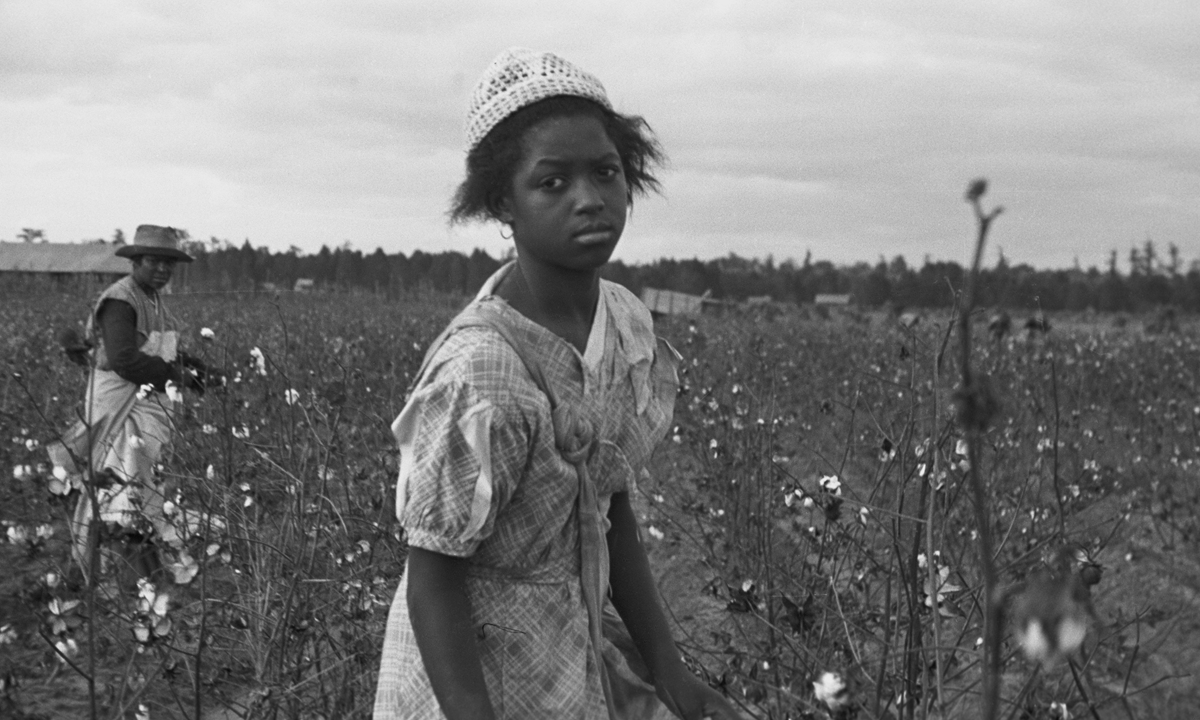
Circa 1935, African Americans pick cotton in Pulaski County, Arkansas. Photo: VCG
It wasn't until the 1930s that the US formally ratified the Forced Labor Convention. In many ways, the US' fortune began with blood, sweat, tears, and ultimate sacrifice of slaves.However, when it comes to the 21st century, the situation in the US seems to be no better.
According to Polaris, labor trafficking victims end up in forced labor in many industries ranging from domestic work to agricultural and animal husbandry industries.
In the domestic work industry, the victims commonly work 12-18 hours a day for little to no pay. They may experience extreme isolation and confinement from the outside world, sexual harassment, high levels of monitoring, debt bondage, and extreme wage theft among many other abuses, according to the Polaris report.
Besides, traffickers exploit workers in the agriculture and the animal husbandry industry, from corn fields to orange orchards, to dairy farms. "Some crops such as tobacco require much more intensive labor to harvest, making them more susceptible to forced labor or exploitation. Tobacco is the crop cited most often on Polaris-operated hotlines, accounting for 10 percent of all agricultural labor trafficking cases. Others frequently mentioned are cattle/dairy, oranges, tomatoes, and strawberries. Often agricultural contracts promise an hourly rate but then pay on a piece-rate basis, which severely limits earning potential and further entraps the victims," said Polaris.
According to cases reported to Polaris-operated hotlines, victims of forced farm labor trafficking are disproportionately Latino male migrant workers, mostly from Mexico and Central America, on seasonal H-2A visas. South African men on H-2A visas rank a distant second. Latinas and unaccompanied foreign minors are also victimized.
Bingwen Yan, President of the Alliance of Minnesota Chinese Organizations, told the Global Times that for a long time, there has been a widespread oppression and exploitation of illegal immigrants, especially Mexican illegal immigrants and refugees coming from places of conflicts.
"Without citizenship and unable to immediately find a decent job in a brand new society, they are left at the bottom of the social totem pole of labor, exploited by capitalists who take advantage of their desperation to earn a living. They do the labor extensive work that Americans are unwilling to do," Yan said.
In 2014, Guatemalan smugglers were advertising that for only $15,000, their children could study, work, and live a good life in the US and they could pay it back when they have enough money in the US. However, soon after arriving in the developed country, these Guatemalan teenagers with the "American dream" had been sold to farms in Ohio and those duped into it were forced to work like slaves to pay off their debts, US media outlet PBS reported.
Hidden exploitation
Latin Americans and Africans are far from the only ones to suffer from this form of brutality. Asian Americans have suffered from unfair treatment in US workplace.
In history, many Chinese workers came to the US to seek a living but were in conditions of forced labor. Take the building of the Transcontinental Railway in the US as an example. Roughly 15,000 to 20,000 Chinese immigrants were involved in it. They toiled in frigid winters and blazing summers with hundreds died from explosions, landslides, diseases and accidents. But they have been ignored by history.
"Many Asians, especially first generation immigrants, choose to work in the US as domestic workers and masseurs. However, these are the hardest hit areas in labor exploitation. The lack of strong oversight bodies and legal protection has made it easier for employers to exploit workers. They often work day and night to earn low wages without adequate benefits and security," Tang Enyang, chairman of the Chinese Restaurant Association in Brooklyn Chinatown in New York, told the Global Times in a previous interview.
According to Tang, during the early stage of the COVID-19 outbreak in the US, some restaurants stayed open, disregarded the health and wellbeing of their employees, extending the working hours of temporary workers in an attempt to reduce losses, even ordering them not to wear personal protective equipment so as not to scare customers. Some retail employees were fired after calling for stores to be closed to prevent the risk of contracting the virus.
"In the post-epidemic era, minorities confront the fragility and divisiveness of the US in the workplace,"Yan said.
Yan noted that currently, Chinese Americans suffer from extensive but hidden labor exploitation in the American society. "In highly sophisticated scientific fields, Chinese American researchers face academic censorship and an increasing number of research areas that marginalize them."
Yan mentioned that hard-working, stoic Asian Americans are also bearing the burden of extreme workplace injury cases in the US, such as the recent mass shootings. More regrettably, it is only when they pay the price in blood that this marginalized group is thrust into the limelight of public opinion, he said.
On March 16, 2021, a shooting spree that occurred at three massage parlors in the metropolitan area of Atlanta claimed the lives of eight people, six of whom were Asian women. Following the massacre, demonstrations across the US propelled the Stop Asian Hate movement.
Unwilling to see that Chinese Americans face more and more injustices and dangers, the alliance Yan serves has organized lectures and seminars to raise awareness of legal rights in case of discrimination and abuse in the US, and to encourage minority groups to speak out.
Yan noted that the voice of minorities in the industry associations and labor unions is very weak, which has made them unable to defend their rights and interests that they are entitled to have.
"What's more, sometimes labor unions in the US also need to compromise with the government to reach a balance of interests. So, effective protection of workers' rights will be a long term task in American society." he said.
Given the harsh working environment in the US, analysts said that instead of playing the "Xinjiang card" to contain China, the US needs to take a look at the forced labor of minority groups and immigrants in the country and show some responsibility as a country claiming to care for the people.
